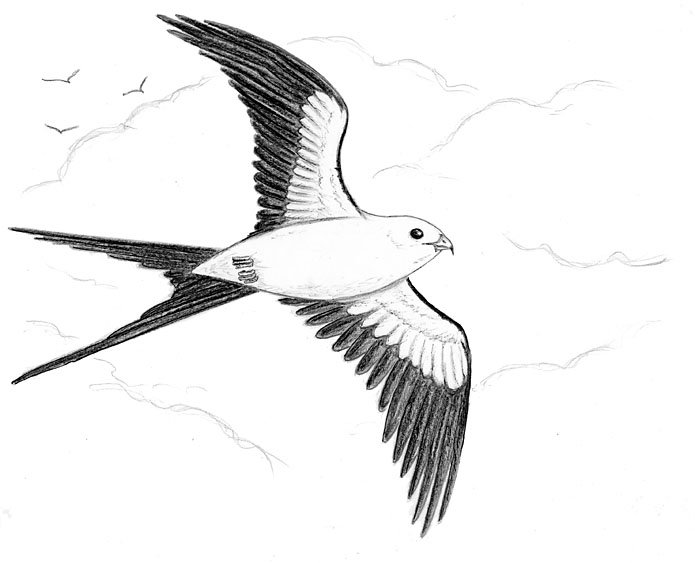
Dear Bird Folks,
I’m not sure if this is a big deal, but I just I noticed an unusual bird flying over my house. According my bird book the bird I saw was a Swallow-tailed Kite. The markings are unmistakable. Yet my book says that kites don’t live in the Northeast. How is this possible? Also, should I tell some authorities about this?
– Eric, Yarmouth, MA
It is a big deal, Eric,
Seeing a Swallow-tailed Kite on Cape Cod is definitely a big deal. Very few birders, including myself, have ever seen one around here. However, you have to be careful which “authorities” you report it to. While birders will knock you over in an attempt to see one of these birds, few others would care, or even know what the heck you are talking about. Most people would just look at you with a blank stare. Contacting me was a good choice. The other people to contact are the birdie folks at the Wellfleet Bay Wildlife Sanctuary (Mass Audubon). They love to keep track of unusual birds. They may even post your sighting on their website. How cool would that be? Getting money for it would be even cooler, but it’s still pretty good.
You are so right about Swallow-tailed Kites being “unmistakable.” They are large birds of prey, nearly the size of an Osprey, but they don’t look or behave like any other birds of prey. As their name implies, they look like a giant black and white swallow, but that is not where the comparison ends. These large raptors feed on insects, picking them out of the air as they swoop about the sky, just like…swallows.
Swallow-tailed Kites are masters of the air. Seeing one in flight is a thing of beauty and it’s about the only way you’ll ever see one. They rarely land except to sleep, breed or occasionally shop at yard sales. If the wind is right, Swallow-tailed Kites seem to have the ability to defy gravity and can literally hang in the sky. They can remain aloft, in the same spot, for long periods without ever flapping or expending any energy. By the way, the kites of the world would like you to know that children’s toy kites are named after them. They would also like you to know that they have never received a nickel in compensation from any toy companies for the use of their name, but a lawsuit is pending.
A kite’s flying skills are so finely tuned that it is able to even drink on the wing. The bird will simply fly low over water and scoop up a mouthful of water as it goes, just like a swallow does. When it comes to feeding, however, the swallow comparison starts to break down. Swallows snag insects out of the air with their large mouths. Kites, on the other hand, are raptors and thus have mouths that are not shaped for food gathering. Instead, kites use their talons to pluck insects out of the air or off tree branches. Then, without ever landing, they transfer the prey to their mouths, and down the hatch it goes.
It’s understandable that a little swallow can live on a total insect diet but how does an Osprey-sized raptor survive on such meager morsels? Well, kites aren’t chowing on fruit flies and no-see-ums; they prefer dragonflies, grasshoppers and cicadas. They also eat wasps. Yes, wasps. And I’m not talking about the WASPs you might find in Yarmouth Port. I’m talking about the stinging kind. This kite has a much thicker stomach lining than other birds, which perhaps helps them deal with any stray stingers. I’m sure a little Zantac comes in handy, too.
When Swallow-tailed Kites have hungry kids to feed they expand their menu considerably. During the breeding season the adult birds capture lizards, snakes, frogs and even the babies of other birds. One kite was seen plucking an entire nest, chicks and all, out of a tree. It then proceeded to eat the chicks one by one as it flew. This was kind of a not-so-happy, Happy Meal.
Swallow-tailed Kites nest in the swamps and wetlands of Florida and in parts of Florida’s neighboring states. When the breeding season is over they all head to South America for the winter. On their wintering grounds the kites will often add fruit to their diet. Eating fruit is unusual for a raptor, but it probably helps them ward off catching an annual winter cold.
When the birds return in the spring some of the younger kites may overshoot the breeding grounds. These are the birds we are likely to see in our area. When I say “we” I mean not me. While I’ve seen these magnificent birds on birding trips in the tropics, I have never been lucky enough to see one around here. You were very fortunate to see a Swallow-tailed Kite in Yarmouth, Eric. Another one of the handsome birds may not wander this way for several years. If you do happen to see another one, please call me right away. Also call the Wellfleet Bay Wildlife Sanctuary. Their phone number is 508-349-2615. Just don’t tell them that you got this number from me. It’s probably time for them to ask me for a donation and I’d hate to remind them that I’m still around.